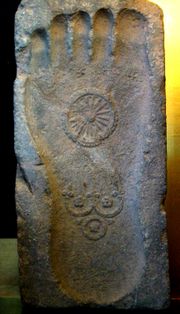 Early Buddhist art followed one Indian aniconic tradition, which avoids direct representation of the human figure. Around the 1st century CE an iconic period emerged lasting to this day which represents the Buddha in human form.
Early Buddhist art followed one Indian aniconic tradition, which avoids direct representation of the human figure. Around the 1st century CE an iconic period emerged lasting to this day which represents the Buddha in human form.
Buddhist art followed believers as the dharma spread, adapted, and evolved in each new host country. It developed to the north through Central Asia and into Eastern Asia to form the Northern branch of Buddhist art, and to the east as far as Southeast Asia to form the Southern branch of Buddhist art. In India, Buddhist art flourished and even influenced the development of Hindu art, until Buddhism nearly disappeared in India around the 10th century due in part to the vigorous expansion of Islam alongside Hinduism.
Aniconic phase (5th century – 1st century BCE)
During the 2nd to 1st century BCE, sculptures became more explicit, representing episodes of the Buddha’s life and teachings. These took the form of votive tablets or friezes, usually in relation to the decoration of stupas. Although India had a long sculptural tradition and a mastery of rich iconography, the Buddha was never represented in human form, but only through some of his symbols.
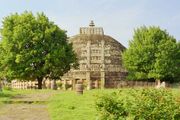
Iconic phase (1st century CE – present)
Anthropomorphic representations of the Buddha started to emerge from the 1st century CE in northern India. The two main centers of creation have been identified as Gandhara in today’s North West Frontier Province , in Pakistan, and the region of Mathura, in central northern India.
The art of Gandhara benefited from centuries of interaction with Greek culture since the conquests of Alexander the Great in 332 BCE and the subsequent establishment of the Greco-Bactrian and Indo-Greek Kingdoms, leading to the development of Greco-Buddhist art. Gandharan Buddhist sculpture displays Greek artistic influence, and it has been suggested that the concept of the “man-god” was essentially inspired by Greek mythological culture. Artistically, the Gandharan school of sculpture is said to have contributed wavy hair, drapery covering both shoulders, shoes and sandals, acanthus leaf decorations, etc.
The art of Mathura tends to be based on a strong Indian tradition, exemplified by the anthropomorphic representation of divinities such as the Yaksas, although in a style rather archaic compared to the later representations of the Buddha. The Mathuran school contributed clothes covering the left shoulder of thin muslin, the wheel on the palm, the lotus seat, etc.
Mathura and Gandhara also strongly influenced each other. During their artistic florescence, the two regions were even united politically under the Kushans, both being capitals of the empire. It is still a matter of debate whether the anthropomorphic representations of Buddha was essentially a result of a local evolution of Buddhist art at Mathura, or a consequence of Greek cultural influence in Gandhara through the Greco-Buddhist syncretism.
This iconic art was characterized from the start by a realistic idealism, combining realistic human features, proportions, attitudes and attributes, together with a sense of perfection and serenity reaching to the divine. This expression of the Buddha as a both a man and a god became the iconographic canon for subsequent Buddhist art.
Buddhist art continued to develop in India for a few more centuries. The pink sandstone sculptures of Mathura evolved during the Gupta period (4th to 6th century) to reach a very high fineness of execution and delicacy in the modeling. The art of the Gupta school was extremely influential almost everywhere in the rest of Asia. By the 10th century, Buddhist art creation was dying out in India, as Hinduism and Islam ultimately prevailed.
As Buddhism expanded outside of India from the 1st century CE, its original artistic package blended with other artistic influences, leading to a progressive differentiation among the countries adopting the faith.
A Northern route was established from the 1st century CE through Central Asia, Tibet, Bhutan, China, Korea, and Japan, in which Mahayana Buddhism prevailed.
A Southern route, where Theravada Buddhism dominated, went through Myanmar, Thailand, Cambodia, and Vietnam.
Northern Buddhist art
The Silk Road transmission of Buddhism to Central Asia, China and ultimately Korea and Japan started in the 1st century CE with a semi-legendary account of an embassy sent to the West by the Chinese Emperor Ming (58-75 CE). However, extensive contacts started in the 2nd century CE, probably as a consequence of the expansion of the Kushan Empire into the Chinese territory of the Tarim Basin, with the missionary efforts of a great number of Central Asian Buddhist monks to Chinese lands. The first missionaries and translators of Buddhists scriptures into Chinese, such as Lokaksema, were either Parthian, Kushan, Sogdian or Kuchean.
Central Asian missionary efforts along the Silk Road were accompanied by a flux of artistic influences, visible in the development of Serindian art from the 2nd through the 11th century CE in the Tarim Basin, modern Xinjiang. Serindian art often derives from the Greco-Buddhist art of the Gandhara district of what is now Pakistan, combining Indian, Greek and Roman influences. Silk Road Greco-Buddhist artistic influences can be found as far as Japan to this day, in architectural motifs, Buddhist imagery, and a select few representations of Japanese gods.
The art of the northern route was also highly influenced by the development of Mahayana Buddhism, an inclusive faith characterized by the adoption of new texts, in addition to the traditional Pali canon, and a shift in the understanding of Buddhism. Mahayana goes beyond the traditional Theravada ideal of the release from suffering (dukkha) and personal enlightenment of the arhats, to elevate the Buddha to a god-like status, and to create a pantheon of quasi-divine Bodhisattvas devoting themselves to personal excellence, ultimate knowledge and the salvation of humanity. Northern Buddhist art thus tends to be characterized by a very rich and syncretic Buddhist pantheon, with a multitude of images of the various Buddhas, Bodhisattvas and lesser deities.
Afghanistan
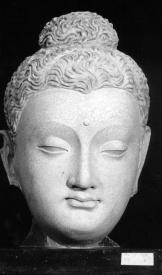 Buddhist art in Afghanistan (old Bactria) persisted for several centuries until the spread of Islam in the 7th century. It is exemplified by the Buddhas of Bamyan. Other sculptures, in stucco, schist or clay, display very strong blending of Indian post-Gupta mannerism and Classical influence, Hellenistic or possibly even Greco-Roman.
Buddhist art in Afghanistan (old Bactria) persisted for several centuries until the spread of Islam in the 7th century. It is exemplified by the Buddhas of Bamyan. Other sculptures, in stucco, schist or clay, display very strong blending of Indian post-Gupta mannerism and Classical influence, Hellenistic or possibly even Greco-Roman.
Although Islamic rule was rather tolerant of other religions “of the Book”, it showed little tolerance for Buddhism, which was perceived as a religion depending on idolatry. Human figurative art forms also being prohibited under Islam, Buddhist art suffered numerous attacks, which culminated with the systematic destructions by the Taliban regime. The Buddhas of Bamyan, the sculptures of Hadda, and many of the remaining artifacts at the Afghanistan museum have been destroyed.
The multiple conflicts since the 1980s also have led to a systematic pillage of archaeological sites apparently in the hope of reselling in the international market what artifacts could be found.
Central Asia
Central Asia long played the role of a meeting place between China, India and Persia. During the 2nd century BCE, the expansion of the Former Han to the West led to increased contact with the Hellenistic civilizations of Asia, especially the Greco-Bactrian Kingdom.
Thereafter, the expansion of Buddhism to the North led to the formation of Buddhist communities and even Buddhist kingdoms in the oases of Central Asia. Some Silk Road cities consisted almost entirely of Buddhist stupas and monasteries, and it seems that one of their main objectives was to welcome and service travelers between East and West.
The eastern part of Central Asia (Chinese Turkestan (Tarim Basin, Xinjiang) in particular has revealed an extremely rich Serindian art (wall paintings and reliefs in numerous caves, portable paintings on canvas, sculpture, ritual objects), displaying multiple influences from Indian and Hellenistic cultures. Works of art reminiscent of the Gandharan style, as well as scriptures in the Gandhari script Kharoshti have been found. These influences were rapidly absorbed however by the vigorous Chinese culture, and a strongly Chinese particularism develops from that point.
China
Buddhism arrived in China around the 1st century CE, and introduced new types of art into China, particularly in the area of statuary. Receiving this distant religion, strong Chinese traits were incorporated into Buddhist art.
Northern Dynasties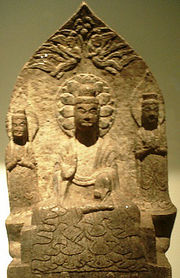
In the 5th to 6th centuries, the Northern Dynasties, developed rather symbolic and abstract modes of representation, with schematic lines. Their style is also said to be solemn and majestic. The lack of corporeality of this art, and its distance from the original Buddhist objective of expressing the pure ideal of enlightenment in an accessible and realistic manner, progressively led to a change towards more naturalism and realism, leading to the expression of Tang Buddhist art.
Sites preserving Northern Wei Dynasty Buddhist sculpture:
Longmen Grottoes, Henan
Bingling Temple, Gansu
Tang Dynasty
Following a transition under the Sui Dynasty, Buddhist sculpture of the Tang evolved towards a markedly life-like expression. Because of the dynasty’s openness to foreign influences, and renewed exchanges with Indian culture due to the numerous travels of Chinese Buddhist monks to India, Tang dynasty Buddhist sculpture assumed a rather classical form, inspired by the Indian art of the Gupta period. During that time, the Tang capital of Chang’an (today’s Xi’an) became an important center for Buddhism. From there Buddhism spread to Korea, and Japanese embassies of Kentoshi helped it gain a foothold in Japan.
However, foreign influences came to be negatively perceived in China towards the end of the Tang dynasty. In the year 845, the Tang emperor Wuzong outlawed all “foreign” religions (including Christian Nestorianism, Zoroastrianism and Buddhism) in order to support the indigenous religion, Taoism. He confiscated Buddhist possessions, and forced the faith to go underground, therefore affecting the development of the religion and its arts in China.
Chán Buddhism however, at the origin of Japanese Zen, continued to prosper for some centuries, especially under the Song Dynasty (960-1279), when Chan monasteries were great centers of culture and learning.
The popularization of Buddhism in China has made the country home to one of the richest collections of Buddhist arts in the world. The Mogao Caves near Dunhuang and the Bingling Temple caves near Yongjing in Gansu province, the Longmen Grottoes near Luoyang in Henan province, the Yungang Grottoes near Datong in Shanxi province, and the Dazu Rock Carvings near Chongqing municipality are among the most important and renowned Buddhist sculptural sites. The Leshan Giant Buddha, carved out of a hillside in the 8th century during the Tang Dynasty and looking down on the confluence of three rivers, is still the largest stone Buddha statue in the world.
Japan
Before the introduction of Buddhism, Japan had already been the seat of various cultural (and artistic) influences, from the abstract linear decorative art of the indigenous Neolithic Jōmon from around 10500 BCE to 300 BCE, to the art during the Yayoi and Kofun periods, with developments such as Haniwa art.
Japan, the largest Buddhist country today, discovered Buddhism in the 6th century when missionary monks travelled to the islands together with numerous scriptures and works of art. The Buddhist religion was adopted by the state in the following century. Being geographically at the end of the Silk Road, Japan was able to preserve many aspects of Buddhism at the very time it was disappearing in India, and being suppressed in Central Asia and China.
From 711, numerous temples and monasteries were built in the capital city of Nara, including a five-story pagoda, the Golden Hall of the Horyuji, and the Kōfuku-ji temple. Countless paintings and sculpture were made, often under governmental sponsorship. Indian, Hellenistic, Chinese and Korean artistic influences blended into an original style characterized by realism and gracefulness. The creation of Japanese Buddhist art was especially rich between the 8th and 13th centuries during the periods of Nara, Heian and Kamakura. Japan developed an extremely rich figurative art for the pantheon of Buddhist deities, sometimes combined with Hindu and Shinto influences. This art can be very varied, creative and bold.
From the 12th and 13th, a further development was Zen art, following the introduction of the faith by Dogen and Eisai upon their return from China. Zen art is mainly characterized by original paintings (such as sumi-e) and poetry (especially haikus), striving to express the true essence of the world through impressionistic and unadorned “non-dualistic” representations. The search for enlightenment “in the moment” also led to the development of other important derivative arts such as the Chanoyu tea ceremony or the Ikebana art of flower arrangement. This evolution went as far as considering almost any human activity as an art with a strong spiritual and aesthetic content, first and foremost in those activities related to combat techniques (martial arts).
Buddhism remains very active in Japan to this day. Still around 80,000 Buddhist temples are preserved. Many of them are in wood and are regularly restored.
Korea
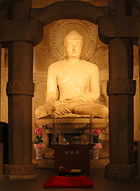 Korean Buddhist art generally reflects an interaction between Chinese Buddhist influence and a strongly original Korean culture. Additionally, the art of the steppes, particularly Siberian and Scythian influences, are evident in early Korean Buddhist art based on the excavation of artifacts and burial goods such as Silla royal crowns, belt buckles, daggers, and comma-shaped gogok. The style of this indigenous art was geometric, abstract and richly adorned with a characteristic “barbarian” luxury. Although Chinese influence was strong, Korean Buddhist art “bespeaks a sobriety, taste for the right tone, a sense of abstraction but also of colours that curiously enough are in line with contemporary taste” (Pierre Cambon, Arts asiatiques- Guimet’).
Korean Buddhist art generally reflects an interaction between Chinese Buddhist influence and a strongly original Korean culture. Additionally, the art of the steppes, particularly Siberian and Scythian influences, are evident in early Korean Buddhist art based on the excavation of artifacts and burial goods such as Silla royal crowns, belt buckles, daggers, and comma-shaped gogok. The style of this indigenous art was geometric, abstract and richly adorned with a characteristic “barbarian” luxury. Although Chinese influence was strong, Korean Buddhist art “bespeaks a sobriety, taste for the right tone, a sense of abstraction but also of colours that curiously enough are in line with contemporary taste” (Pierre Cambon, Arts asiatiques- Guimet’).
Three Kingdoms of Korea
The first of the Three Kingdoms of Korea to officially receive Buddhism was Goguryeo in 372. However, Chinese records and the use of Buddhist motifs in Goguryeo murals indicate the introduction of Buddhism earlier than the official date. The Baekje Kingdom officially recognized Buddhism in 384. The Silla Kingdom, isolated and with no easy sea or land access to China, officially adopted Buddhism in 535 although the foreign religion was known in the kingdom due to the work of Goguryeo monks since the early fifth century. The introduction of Buddhism stimulated the need for artisans to create images for veneration, architects for temples, and the literate for the Buddhist sutras and transformed Korean civilization. Particularly important in the transmission of sophisticated art styles to the Korean kingdoms was the art of the “barbarian” Tuoba, a clan of non-Han Chinese Xianbei people who established the Northern Wei Dynasty in China in 386. The Northern Wei style was particularly influential in the art of the Goguryeo and Baekje. Baekje artisans later transmitted this style along with Southern Dynasty elements and distinct Korean elements to Japan. Korean artisans were highly selective of the styles they incorporated and combined different regional styles together to create a specific Korean Buddhist art style.
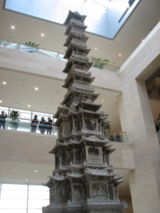 While Goguryeo Buddhist art exhibited vitality and mobility akin with Northern Wei prototypes, the Baekje Kingdom was also in close contact with the Southern Dynasties of China and this close diplomatic contact is exemplified in the gentle and proportional sculpture of the Baekje, epitomized by Baekje sculpture exhibiting the fathomless smile known to art historians as the Baekje smile. The Silla Kingdom also developed a distinctive Buddhist art tradition epitomized by the Bangasayusang, a half-seated contemplative maitreya whose Korean-made twin, the Miroku Bosatsu, was sent to Japan as a proselytizing gift and now resides in the Koryu-ji Temple in Japan. Buddhism in the Three Kingdoms period stimulated massive temple-building projects, such as the Mireuksa Temple in the Baekje Kingdom and the Hwangnyongsa Temple in Silla. Baekje architects were famed for their skill and were instrumental in building the massive nine-story pagoda at Hwangnyongsa and early Buddhist temples in Yamato Japan such as Hoko-ji (Asuka-dera) and Hōryū-ji. Sixth century Korean Buddhist art exhibited the cultural influences of China and India but began to show distinctive indigenous characteristics.These indigenous characteristics can be seen in early Buddhist art in Japan and some early Japanese Buddhist sculpture is now believed to have originated in Korea, particularly from Baekje, or Korean artisans who immigrated to Yamato Japan. Particularly, the semi-seated Maitreya form was adapted into a highly developed Korean style which was transmitted to Japan as evidenced by the Koryu-ji Miroku Bosatsu and the Chugu-ji Siddhartha statues. Although many historians portray Korea as a mere transmitter of Buddhism, the Three Kingdoms, and particularly Baekje, were instrumental as active agents in the introduction and formation of a Buddhist tradition in Japan in 538 or 552.
While Goguryeo Buddhist art exhibited vitality and mobility akin with Northern Wei prototypes, the Baekje Kingdom was also in close contact with the Southern Dynasties of China and this close diplomatic contact is exemplified in the gentle and proportional sculpture of the Baekje, epitomized by Baekje sculpture exhibiting the fathomless smile known to art historians as the Baekje smile. The Silla Kingdom also developed a distinctive Buddhist art tradition epitomized by the Bangasayusang, a half-seated contemplative maitreya whose Korean-made twin, the Miroku Bosatsu, was sent to Japan as a proselytizing gift and now resides in the Koryu-ji Temple in Japan. Buddhism in the Three Kingdoms period stimulated massive temple-building projects, such as the Mireuksa Temple in the Baekje Kingdom and the Hwangnyongsa Temple in Silla. Baekje architects were famed for their skill and were instrumental in building the massive nine-story pagoda at Hwangnyongsa and early Buddhist temples in Yamato Japan such as Hoko-ji (Asuka-dera) and Hōryū-ji. Sixth century Korean Buddhist art exhibited the cultural influences of China and India but began to show distinctive indigenous characteristics.These indigenous characteristics can be seen in early Buddhist art in Japan and some early Japanese Buddhist sculpture is now believed to have originated in Korea, particularly from Baekje, or Korean artisans who immigrated to Yamato Japan. Particularly, the semi-seated Maitreya form was adapted into a highly developed Korean style which was transmitted to Japan as evidenced by the Koryu-ji Miroku Bosatsu and the Chugu-ji Siddhartha statues. Although many historians portray Korea as a mere transmitter of Buddhism, the Three Kingdoms, and particularly Baekje, were instrumental as active agents in the introduction and formation of a Buddhist tradition in Japan in 538 or 552.
Unified Silla
During the Unified Silla period, East Asia was particularly stable with China and Korea both enjoying unified governments. Early Unified Silla art combined Silla styles and Baekje styles. Korean Buddhist art was also influenced by new Tang Dynasty styles as evidenced by a new popular Buddhist motif with full-faced Buddha sculptures. Tang China was the cross roads of East, Central, and South Asia and so the Buddhist art of this time period exhibit the so-called international style. State-sponsored Buddhist art flourished during this period, the epitome of which is the Seokguram Grotto.
Goryeo Dynasty
The fall of the Unified Silla Dynasty and the establishment of the Goryeo Dynasty in 918 indicates a new period of Korean Buddhist art. The Goryeo kings also lavishly sponsored Buddhism and Buddhist art flourished, especially Buddhist paintings and illuminated sutras written in gold and silver ink. The crowning achievement of this period is the carving of approximately 80,000 woodblocks of the Tripitaka Koreana which was done twice.
Joseon Dynasty
The Joseon Dynasty actively suppressed Buddhism beginning in 1406 and Buddhist temples and art production subsequently decline in quality in quantity although beginning in 1549, Buddhist art does continue to be produced.
Tibet and Bhutan
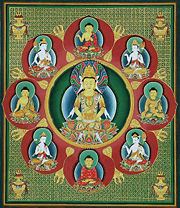 Tantric Buddhism started as a movement in eastern India around the 5th or the 6th century. Many of the practices of Tantric Buddhism are derived from Brahmanism (the usage of mantras, yoga, or the burning of sacrificial offerings). Tantrism became the dominant form of Buddhism in Tibet from the 8th century. Due to its geographical centrality in Asia, Tibetan Buddhist art received influence from Indian, Nepali, Greco-Buddhist and Chinese art.
Tantric Buddhism started as a movement in eastern India around the 5th or the 6th century. Many of the practices of Tantric Buddhism are derived from Brahmanism (the usage of mantras, yoga, or the burning of sacrificial offerings). Tantrism became the dominant form of Buddhism in Tibet from the 8th century. Due to its geographical centrality in Asia, Tibetan Buddhist art received influence from Indian, Nepali, Greco-Buddhist and Chinese art.
One of the most characteristic creations of Tibetan Buddhist art are the mandalas, diagrams of a “divine temple” made of a circle enclosing a square, the purpose of which is to help Buddhist devotees focus their attention through meditation and follow the path to the central image of the Buddha. Artistically, Buddhist Gupta art and Hindu art tend to be the two strongest inspirations of Tibetan art.
See also: Tibetan art, Bhutanese art, Buddha Dordenma statue
Vietnam
Chinese influence was predominant in the north of Vietnam (Tonkin) between the 1st and 9th centuries, and Confucianism and Mahayana Buddhism were prevalent. Overall, the art of Vietnam has been strongly influenced by Chinese Buddhist art.
Myanmar
A neighbor of India, Myanmar was naturally strongly influenced by the eastern part of Indian territory. The Mon of southern Burma are said to have been converted to Buddhism around 200 BCE under the proselytizing of the Indian king Ashoka, before the schism between Mahayana and Hinayana Buddhism.
Early Buddhist temples are found, such as Beikthano in central Myanmar, with dates between the 1st and the 5th centuries. The Buddhist art of the Mons was especially influenced by the Indian art of the Gupta and post-Gupta periods, and their mannerist style spread widely in Southeast Asia following the expansion of the Mon Empire between the 5th and 8th centuries.
Later, thousands of Buddhist temples were built at Bagan, the capital, between the 11th and 13th centuries, and around 2,000 of them are still standing. Beautiful jeweled statues of the Buddha are remaining from that period. Creation managed to continue despite the seizure of the city by the Mongols in 1287.
Cambodia
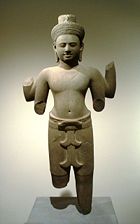 Cambodia was the center of the Funan kingdom, which expanded into Burma and as far south as Malaysia between the 3rd and 6th centuries CE. Its influence seems to have been essentially political, most of the cultural influence coming directly from India.
Cambodia was the center of the Funan kingdom, which expanded into Burma and as far south as Malaysia between the 3rd and 6th centuries CE. Its influence seems to have been essentially political, most of the cultural influence coming directly from India.
Later, from the 9th to 13th centuries, the Mahayana Buddhist and Hindu Khmer Empire dominated vast parts of the Southeast Asian peninsula, and its influence was foremost in the development of Buddhist art in the region. Under the Khmer, more than 900 temples were built in Cambodia and in neighboring Thailand.
Angkor was at the center of this development, with a Buddhist temple complex and urban organization able to support around 1 million urban dwellers. A great deal of Cambodian Buddhist sculpture is preserved at Angkor; however, organized looting has had a heavy impact on many sites around the country.
Often, Khmer art manages to express intense spirituality through divinely beaming expressions, in spite of spare features and slender lines.
See also: Khmer art, Khmer sculpture.
Thailand
From the 1st to the 7th centuries, Buddhist art in Thailand was first influenced by direct contact with Indian traders and the expansion of the Mon kingdom, leading to the creation of Hindu and Buddhist art inspired from the Gupta tradition, with numerous monumental statues of great virtuosity.
From the 9th century, the various schools of Thai art then became strongly influenced by Cambodian Khmer art in the north and Sri Vijaya art in the south, both of Mahayana faith. Up to the end of that period, Buddhist art is characterized by a clear fluidness in the expression, and the subject matter is characteristic of the Mahayana pantheon with multiple creations of Bodhisattvas.
From the 13th century, Theravada Buddhism was introduced from Sri Lanka around the same time as the ethnic Thai kingdom of Sukhothai was established. The new faith inspired highly stylized images in Thai Buddhism, with sometimes very geometrical and almost abstract figures.
During the Ayutthaya period (14th-18th centuries), the Buddha came to be represented in a more stylistic manner with sumptuous garments and jeweled ornamentations. Many Thai sculptures or temples tended to be gilded, and on occasion enriched with inlays.
Indonesia
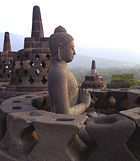 Like the rest of Southeast Asia, Indonesia seems to have been most strongly influenced by India from the 1st century CE. The islands of Sumatra and Java in western Indonesia were the seat of the empire of Sri Vijaya (8th-13th century CE), which came to dominate most of the area around the Southeast Asian peninsula through maritime power. The Sri Vijayan Empire had adopted Mahayana and Vajrayana Buddhism, under a line of rulers named the Sailendras. Sri Vijaya spread Mahayana Buddhist art during its expansion into the Southeast Asian peninsula. Numerous statues of Mahayana Bodhisattvas from this period are characterized by a very strong refinement and technical sophistication, and are found throughout the region.
Like the rest of Southeast Asia, Indonesia seems to have been most strongly influenced by India from the 1st century CE. The islands of Sumatra and Java in western Indonesia were the seat of the empire of Sri Vijaya (8th-13th century CE), which came to dominate most of the area around the Southeast Asian peninsula through maritime power. The Sri Vijayan Empire had adopted Mahayana and Vajrayana Buddhism, under a line of rulers named the Sailendras. Sri Vijaya spread Mahayana Buddhist art during its expansion into the Southeast Asian peninsula. Numerous statues of Mahayana Bodhisattvas from this period are characterized by a very strong refinement and technical sophistication, and are found throughout the region.
Extremely rich and refined architectural remains are found in Java and Sumatra. The most magnificent is the temple of Borobudur (the largest Buddhist structure in the world, built around 780-850 AD). This temple is modelled after the Buddhist concept of universe, the Mandala which counts 505 images of the seated Buddha and unique bell-shaped stupa that contains the statue of Buddha. Borobudur is adorned with long series of bas-reliefs narrated the holy Buddhist scriptures. The oldest Buddhist structure in Indonesia probably is the Batu Jaya stupas at Karawang, West Java, dated from around 4th century AD. This temple is some plastered brick stupas. However, Buddhist art in Indonesia reach the golden era during the Sailendra dynasty rule in Java. The bas-reliefs and statues of Boddhisatva, Tara, and Kinnara found in Kalasan, Sewu, Sari, and Plaosan temple is very graceful with serene expression, While Mendut temple near Borobudur, houses the giant statue of Buddha, Avalokitesvara, and Vajrapani.
In Sumatra Sri Vijaya probably built the temple of Muara Takus, and Muaro Jambi. The most beautiful classical Javanese art is the serene and delicate statue of Prajnaparamita (the collection of National Museum Jakarta) the goddess of transcendental wisdom from Singhasari. The Indonesian Buddhist Empire of Sri Vijaya declined due to conflicts with the Chola rulers of India, then followed by Majapahit empire, before being destabilized by the Islamic expansion from the 13th century.
– Source: Buddhist art




